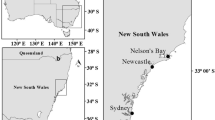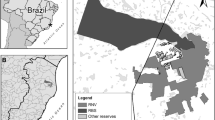Abstract
The diet of Daubenton’s batMyotis daubentonii (Kuhl, 1817), which takes prey by aerial hawking and from the surface of water, was investigated by analysis of faeces collected in summer at 7 roosts, all close to rivers in pastoral land, in three widely-separated districts in Ireland. Forty-seven categories of arthropod prey were identified; several were insect taxa found in and around water. Most categories were recovered at most roosts, but mainly in small amounts. The main categories were the same throughout, accounting for 82% of the diet by percentage frequency in droppings for pooled data: Chironomidae/Ceratopogonidae 24% (adults 14%, preadult stages 10%), other nematoceran Diptera 21%, other Diptera 10%, and Trichoptera 26% (adults 20%, preadult 6%). A quarter of the prey had evidently been obtained from the water’s surface (eg aquatic insects, their larvae and pupae). Although consumption of several food items varied significantly by month at one or more roosts, little of such variation was consistent between roosts.
Similar content being viewed by others
References
Beck A. 1995. Fecal analyses of European bat species. Myotis 32–33: 109–119.
Bogdanowicz W. 1994.Myotis daubentonii. Mammalian Species 475: 1–9.
Chinery M. 1993. Insects of Britain and Northern Europe. 3rd edition. Collins, London: 1–320.
Frost W. E. 1939. River Liffey Survey. II. The food consumed by the brown trout (Salmo trutta L.) in acid and alkaline water. Proceedings of the Royal Irish Academy 45B: 139–206.
Jones G. and Rayner J. M. V. 1988. Flight performance, foraging tactics and echolocation in free-living Daubenton’s batsMyotis daubentonii (Chiroptera: Vespertilionidae). Journal of Zoology, London 215: 113–132.
Kalko E. K. V. and Schnitzler H.-U. 1989. The echolocation and hunting behaviour of Daubenton’s bat,Myotis daubentoni. Behavioural Ecology and Sociobiology 24: 225–238.
Kokurewicz T. 1995. Increased population of Daubenton’s bat [Myotis daubentoni (Kuhl, 1819)] (Chiroptera: Vespertilionidae) in Poland. Myotis 32–33: 155–161.
Lucey J., Bowman J. J., Clabby K. J., Cunningham P., Lehane M., MacCárthaigh M., McGarrigle M. L. and Toner P. F. 1999. Water quality in Ireland. Environmental Protection Agency, Wexford: 1–292.
Maitland P. S. and Campbell R. N. 1992. Freshwater fishes of the British Isles. Collins, London: 1–368.
McAney C. M. and Fairley J. S. 1989. Analysis of the diet of the lesser horseshoe batRhinolophus hipposideros in the West of Ireland. Journal of Zoology, London 217: 491–498.
Racey P. A., Swift S. M., Rydell J. and Brodie L. 1998. Bats and insects over two Scottish rivers with contrasting nitrate status. Animal Conservation 1: 195–202.
Rydell J., Entwhistle A. and Racy P. A. 1996. Timing of foraging flights of three species of bats in relation to insect activity and predation risk. Oikos 76: 243–252.
Shiel C. B., Duvergé P. L., Smiddy P. and Fairley J. S. 1998. Analysis of the diet of Leisler’s bat (Nyctalus leisleri) in Ireland with some comparative analyses from England and Germany. Journal of Zoology, London 246: 417–425.
Shiel C., McAney C., Sullivan C. and Fairley J. 1997. Identification of arthropod fragments in bat droppings. Mammal Society, London: 1–56.
Sullivan C. M., Shiel C., McAney C. M. and Fairley J. S. 1993. Analysis of the diets of Leisler’sNyctalus leisleri, Daubenton’sMyotis daubentoni and pipistrellePipistrellus pipistrellus bats in Ireland. Journal of Zoology, London 231: 656–663.
Swift S. M. and Racey P. A. 1983. Resource partitioning of two species of vespertilionid bats (Chiroptera) occupying the same roost. Journal of Zoology, London 200: 249–259.
Taake K.-H. 1992. Strategien der Ressourcennutzung an Waldgewässern jagender Fledermäuse (Chiroptera: Vespertilionidae). Myotis 30: 7–73.
Vaughan N. 1997. The diets of British bats. Mammal Review 27: 77–94.
Whitaker J. O. 1988. Food habits analysis of insectivorous bats. [In: Ecological and behavioural methods for the study of bats. T. H. Kunz, ed]. Smithsonian Institute, Washington, D.C: 171–189.
Author information
Authors and Affiliations
Rights and permissions
About this article
Cite this article
Flavin, D.A., Biggane, S.S., Shiel, C.B. et al. Analysis of the diet of Daubenton’s batMyotis daubentonii in Ireland. Acta Theriol 46, 43–52 (2001). https://doi.org/10.1007/BF03192415
Received:
Accepted:
Issue Date:
DOI: https://doi.org/10.1007/BF03192415




